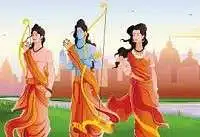
Indian Mythology
Read the passages given below and answer the questions that follow them:
1. Indian mythology is not confined to the epics; it goes back to the Vedic period and appears in many forms and garbs in Sanskrit literature. The poets and the dramatists take full advantage of it and build their stories and lovely fancies round it. The Ashoka tree is said to have burst into flower when touched by the foot of a beautiful woman. We read of the adventures of the Kama, the god of love, and his wife, Rati (or rapture), with their friend Vasanta, the god of spring. Greatly daring, Kama shoots his flowery arrow at Shiva himself and is reduced to ashes by the fire that flashed out of Shiva’s third eye. But he survives as Ananga, the bodiless one.
2. Most of the myths and stories are heroic in conception and teach adherence to truth and the pledged word, whatever the consequences, faithfulness unto death and even beyond, courage, good works and sacrifice for the common good. Sometimes the story is pure myth, or else it is a mixture of fact and myth, an exaggerated account of some incident that tradition preserved. Facts and fiction are so interwoven as to be inseparable, and this amalgam becomes an imagined history, which may not tell us exactly what happened but does tell us something that is equally important — what people believed had taken place, what they thought their heroic ancestors were capable of, and what ideals inspired them. So, whether fact or fiction, it became a living element in their lives, ever pulling them up from the drudgery and ugliness of their everyday existence to higher realms, ever pointing towards the path of endeavour and right living, even though the ideal might be far off and difficult to reach.
3. Thus, this imagined history, a mixture of fact and fiction, or sometimes only fiction becomes symbolically true and tells us of the minds and hearts and purposes of the people of the particular epoch. It is true also in the sense that it becomes the basis for thought and action, for future history.
Word Meaning: Mythology—very old stories and beliefs, Garbs—forms, Rapture—highest pleasure, Exaggerated—over-stretched, Interwoven—woven together, Amalgam—mixture, Drudgery—dull hard work, Endeavour—efforts, Epoch—era,
Attempt any eight of the following questions on the basis of the passage you have read.
1. How is Indian mythology not confined only to the epics?
2. Give two examples of lovely fanciful stories in Sanskrit literature.
3. Why was the Kama reduced to ashes?
4. How does the Kama survive even today?
5. What are the conception and teachings of the myths?
6. How are facts and fiction interwoven in the stories?
7. Why are these myths and stories still important?
8. How have the stories and myths become a living element in the lives of the people?
9. Find a word in paragraph 3 that means ‘an era’.
Answers
1. Indian mythology is not confined only to the two epics. They go back to the Vedic period and appear in many forms and garbs in Sanskrit literature.
2. One fanciful story is that the Ashoka tree is said to have burst into a flower when touched by the foot of a beautiful woman. The other is how the Kama was reduced to ashes by Shiva.
3. The Kama shoots his flowery arrow at Shiva himself who is in meditation. Shiva in anger opens his third eye and the fire that flashes out reduces the Kama into ashes.
4. The Kama survives as Ananga, the bodiless one even today.
5. The myths and stories are heroic in conception. They teach adherence to truth, faithfulness and the virtue of sacrifice.
6. Facts and fiction are interwoven in myths and stories. There are exaggerated accounts but they become an imagined history.
7. The imagined history of these myths and stories may not tell us exactly what happened. They do tell us about our ancestry and their ideals.
8. The myths and the stories have become a living element in the lives of the people. They pull them up from the drudgery and ugliness of their everyday existence to higher realms.
9. Epoch.
Download the above Passage Worksheet in PDF (Printable)
More Comprehension Pasages:-
Passage -31 Jambheshwarji (360 Words Subjective Solved)
Passage -32 Living Stone (400 Words Subjective Solved)
Passage -33 Dolphins (350 Words Subjective Solved)
This passage is all about dolphins facts and dolphins animal. It describes how dolphins are mammals and dolphins are intelligent. Additionally, it describes dolphins food, dolphins features, dolphins for kids, dolphins habitat, dolphins in India, dolphins types
Passage -34 Neem (300 Words Subjective Solved)
Passage -35 Elephants Nature’s Nomads (400 Words Subjective Solved)
Passage -36 Camps To Tap Creativity (300 Words Subjective Solved)
Passage -37 Asteroids (350 Words Subjective Solved)
Passage -38 Flying Low And High (400 Words Subjective Unsolved)
Passage -39 A Fighting Chance Against TB (350 Words Subjective Unsolved)
Passage -40 Sir Harry Hamilton (400 Words Subjective Solved)